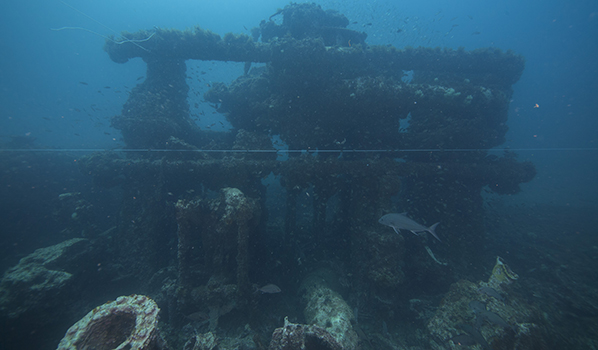How marine creatures have adapted to life in sunken World War II ships

In March 1942, the USA had only been involved in World War II for a few months. German submarines were already lurking near the Atlantic coast, hunting for supply ships and battleships. At the end of the month, a U-71 discovered the Dixie Arrow, an oil tanker Transporting more than 86,000 barrels of crude oil from Texas to New Jersey.
The submarine fired two torpedoes at the target. Within a minute, the tanker was engulfed in flames and sank. 22 crew members were able to get to safety; eleven were killed in the attack.
The tanker sank 90 feet to the sea floor and landed upright. Over the decades, the ship became part of the seascape. It is now one of many sunken ships from World War II that have been used by marine life as a hunting, hiding or home base.
Impact of shipwrecks on the environment
More than three million known shipwrecks have found their way to the bottom of the world’s waterways. Although ships have been sinking for thousands of years, the scientific study of these wrecks is more recent. In the 1920s, British scientist Lilian Lyle examined a wreck in Scapa Flow (a body of water between the Orkney Islands in Scotland) and began scientific research into sunken ships.
The study of shipwrecks has evolved over the last century and now encompasses numerous disciplines, including archaeology, ecology, engineering and oceanography.
Read more: What are spooky ghost ships and what impact do they have on the environment?
In some cases, scientists have discovered shipwrecks as “ecological treasures,” says Avery Paxton, a marine biologist at NOAA’s National Centers for Coastal Ocean Science.
“Shipwrecks can be hotspots for biodiversity. These places can be so full of life, from tiny organisms smaller than my fingernail to the largest animals in the ocean,” says Paxton.
Shipwrecks can attract microorganisms and small creatures such as sponges and corals. Fish of all sizes use shipwrecks as feeding grounds or hiding places. During migrations, sharks can use a sunken ship as a resting place, making some sunken ships like highway rest stops in the ocean.
Habitats and shipwrecks
When a sunken ship reaches the sea floor, Paxton says, it doesn’t form its own habitat. “It sinks onto a habitat. Over time, it becomes part of the habitat,” she says.
How long it takes for the ship to become part of the habitat depends on many factors, including location, water depth and ship material. Some ships, such as the Dixie Arrow, are unharmed and land upright in the sand as if they were anchored in the harbor.
The Dixie Arrow is now covered with living plants, corals and sponges. Schools of fish of all sizes circle the ship while sharks patrol nearby.
Other ships, such as a Freighter, the Transporting sugar, are broken into pieces. The Manuela sank in June 1942 off the coast of North Carolina after being torpedoed by a U-404. The ship did not sink at first, so all but two of the crew were able to get to safety. A tug attempted to tow it, but the Manuela sank.
Manuela, January 22, 1942, location unknown. (Source: Courtesy of Steamship Historical Society)
The pieces are large and have formed a debris field that has been covered by plants over time. The pieces now provide opportunities for fish to hide, hunt or rest.
“It’s almost like these wrecks start a second life. Their first life is spent in service, especially World War II ships, and then when they are shipwrecked, they start a second life,” says Paxton.
Propeller and tail section of Manuela. (Source: Hoyt, NOAA)
Read more: Shipwrecks are teeming with underwater life, from microbes to sharks
The environmental hazards of shipwrecks
Although scientists have identified World War II wrecks that are well adapted to the seabed, most abandoned or sunken ships pose a problem for the environment.
Scientists like Paxton warn that boaters should think they are doing the environment a favor by intentionally sinking their unwanted boats.
“Despite their ecological benefits, shipwrecks can pose a threat to underwater life,” says Paxton.
Escaping pollutants
When a ship sinks, it doesn’t land gently on the sea floor. It can crush and destroy existing habitats, such as coral reefs. According to Paxton, sunken ships can also release harmful pollutants into the marine environment.
The Dixie Arrow, for example, transported more than 86,000 barrels of oil. To illustrate: NOAA keeps records of the biggest oil disasters in US waters since 1969. The Dixie Arrow would be 15th on the list.
NOAA is not sure what to do with the oil on the Dixie Arrow because the barrels are not at the wreck. In its description of the wreck, the authorities describe the 86,000 barrels as lost at sea: “The fuel cargo has long been lost and there is no oil left on site.”
Invasive species
Even if a sunken ship doesn’t destroy the habitat beneath it or introduce pollutants, it could introduce an invasive species. Paxton says invasive species could also find a home in a sunken ship and thrive in an environment where they might not have otherwise survived.
For example, off the Atlantic coast, researchers observed a invasive coral growth on sunken ships from World War II. The corals can alter the habitat by displacing native corals and sponges. When the habitat changes, smaller fish may no longer be able to use it for hiding, which means larger fish may no longer be able to use it for hunting.
Scientists and government agencies are trying Stop the spread of invasive species by removing sunken ships. They are also working on early detection techniques and in some places As in Florida, they are asking the public for help. Divers and snorkelers are asked to report any sightings of invasive corals.
Authorities can remove invasive corals if they are detected early, but once an invasive species begins to spread, it is very difficult to eradicate, according to authorities.
Read more: This World War II shipwreck is flushing pollutants into the North Sea
Article sources
Our authors at Discovermagazine.com We use peer-reviewed studies and high-quality sources for our articles, and our editors verify scientific accuracy and editorial standards. Review the sources used for this article below:
Emilie Lucchesi has written for some of the largest newspapers in the country, including The New York Times, Chicago Tribune, and Los Angeles Times. She holds a bachelor’s degree in journalism from the University of Missouri and an MA from DePaul University. She also holds a Ph.D. in communications from the University of Illinois-Chicago with a focus on media design, message construction, and stigma communications. Emilie has written three nonfiction books. Her third book, A Light in the Dark: Surviving More Than Ted Bundy, will be published October 3, 2023 by Chicago Review Press and is co-authored with survivor Kathy Kleiner Rubin.



:quality(70)/cloudfront-us-east-1.images.arcpublishing.com/adn/ONXT3EEX25HEPI5FXBTS5IJS5Q.jpeg)